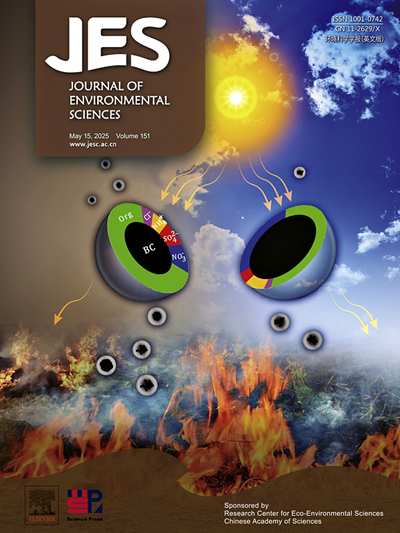Identification and preparation of debromination products of DBDPE photodegradation by HPLC-APPI-MS coupled to semi-preparative liquid chromatography
IF 5.9
2区 环境科学与生态学
Q1 ENVIRONMENTAL SCIENCES
引用次数: 0
Abstract
Decabromodiphenyl ethane (DBDPE) is widely used as an additive flame retardant and has led to global pollution. Its has a large molecular mass and is prone to debromination and degradation under photothermal conditions, resulting in smaller homologous compounds. Due to the lack of standard substances for debromination products, the in-depth study of DBDPE environmental geochemical behavior through debromination conversion has been hindered. Therefore, based on DBDPE photodegradation experiment, this study first analyzed and identified the brominated products of DBDPE using high-performance liquid chromatography-atmospheric pressure photoionization-time of flight mass spectrometry (HPLC-APPI-TOF/MS). Four debromination products-nonabromodiphenyl ethane (nona-BDPE), octabromodiphenyl ethane (octa-BDPE), heptabromodiphenyl ethane (hepta-BDPE) and hexabromodiphenyl ethane (hexa-BDPE) are identified based on the characteristic ion peak of [M-Br+O]- in negative ion mode. Subsequently, using methanol as the mobile phase, four debromination products of DBDPE were separated and purified with a semi-preparative high-performance liquid chromatography (SP-HPLC) system equipped with an Agilent Zorbax Eclipse PAH column (4.6 mm × 250 mm, 5 µm). The first-time acquisition of hexa-BDPE (60.00 µg), octa-BDPE (19.40 µg), hepta-BDPE (31.20 µg) and octa-BDPE (isomer, 45.20 µg) with purity exceeding 90 % has been achieved. Among them, the purity of one hepta-BDPE monomer is as high as 98.91 %. This study indicates that based on photodegradation experiments, the combination of HPLC-APPI-TOF/MS and SP-HPLC techniques can rapidly identify and prepare DBDPE debrominated products. This approach meets the requirements for preliminary research on the pollution characteristics of DBDPE debrominated compounds and offers a feasible solution for the preparation of standard reference materials for emerging pollutants.

hplc - api - ms耦合半制备液相色谱法鉴定和制备DBDPE光降解脱溴产物
十溴二苯乙烷(DBDPE)是一种广泛使用的阻燃添加剂,已造成全球污染。它具有较大的分子质量,在光热条件下容易脱溴和降解,产生较小的同源化合物。由于脱溴产物缺乏标准物质,阻碍了DBDPE脱溴转化环境地球化学行为的深入研究。因此,本研究在DBDPE光降解实验的基础上,首先采用高效液相色谱-大气压光电离飞行时间质谱(hplc - api - tof /MS)对DBDPE的溴化产物进行了分析鉴定。根据负离子模式下[M-Br+O]-的特征离子峰,鉴定了四种脱溴产物:非溴二苯乙烷(nona-BDPE)、八溴二苯乙烷(octa-BDPE)、七溴二苯乙烷(hepta-BDPE)和六溴二苯乙烷(hexa-BDPE)。随后,以甲醇为流动相,采用半制备型高效液相色谱(SP-HPLC)系统,采用安捷伦Zorbax Eclipse多环芳烃柱(4.6 mm × 250 mm, 5µm)对DBDPE的4种脱溴产物进行分离纯化。首次获得了纯度超过90%的六- bdpe(60.00µg)、八- bdpe(19.40µg)、七- bdpe(31.20µg)和八- bdpe(异构体,45.20µg)。其中,一种庚- bdpe单体纯度高达98.91%。本研究表明,在光降解实验的基础上,结合hplc - api - tof /MS和SP-HPLC技术可以快速鉴定和制备DBDPE脱溴产物。该方法满足了DBDPE脱溴化合物污染特性初步研究的要求,为新兴污染物标准品的制备提供了可行的解决方案。
本文章由计算机程序翻译,如有差异,请以英文原文为准。
求助全文
约1分钟内获得全文
求助全文
来源期刊

Journal of Environmental Sciences-china
环境科学-环境科学
CiteScore
13.70
自引率
0.00%
发文量
6354
审稿时长
2.6 months
期刊介绍:
The Journal of Environmental Sciences is an international journal started in 1989. The journal is devoted to publish original, peer-reviewed research papers on main aspects of environmental sciences, such as environmental chemistry, environmental biology, ecology, geosciences and environmental physics. Appropriate subjects include basic and applied research on atmospheric, terrestrial and aquatic environments, pollution control and abatement technology, conservation of natural resources, environmental health and toxicology. Announcements of international environmental science meetings and other recent information are also included.
 求助内容:
求助内容: 应助结果提醒方式:
应助结果提醒方式:


